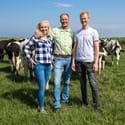Based in the Netherlands, Anton Stokman’s farm is a leader when it comes to animal welfare.
The farm operates a Free Choice system that allows the herd of 180 cows to manage their time as they like. Waterbeds and robotic milking keep the cows happy and healthy, while regular foot baths and professional foot care keep the incidence of lameness extremely low.
Sustainability and environmental protection are also key issues, and the Stokman Farm was the first dairy unit in the Netherlands to be accredited with the Green Facility Mark, a government award for novel solutions to ecological challenges.
“Flagship Farms gives me the opportunity to learn about the way McDonald’s is looking at farming, food and business. For instance, I learned about the importance of being proud of your company.”
Key areas of sustainable practice
The farm is a member of the farm assurance scheme Foqus, which is audited and certified by an independent organization and covers key aspects such as food safety, and animal health and welfare.
Anton’s farm was the first dairy unit in the Netherlands to be accredited with the “Green Mark Facility.” This is awarded by the Dutch Government’s Environmental Department and includes awards for best environmental solution to a problem.
The farm is a member of the independently inspected Qarant farm assurance scheme which covers key aspects such as food safety, animal health and welfare.
The farm first introduced robotic milking over 14 years ago. Anton believes that one of the most important benefits of this system is that it gives the cows “free choice” as to when they want to be milked and allows them to manage their own daily time schedules. This technology has improved milk yields and animal health, reduced somatic cell counts and has eliminated the labor requirement needed for milking.
Dual-chamber waterbeds are installed in all cow cubicles; these improve cow comfort and reduce injuries such as swollen hocks or hock lesions. Research shows that cows need to lie down for 10 to 12 hours per day (Albright, 2003), so this comfortable lying environment is of paramount importance. The waterbed also reduces the quantity of bedding required per cow, and remains cleaner and more hygienic than other lying systems.
Passageways are auto-scraped every hour, which limits the time slurry in the passageways can release ammonia, reducing nitrogen emissions.
Weekly foot-bathing of all cows and tri-annual professional foot trimming ensure that hoof care is at the forefront of animal care, and as a result, the incidence of lameness within the herd is extremely low. The farm recognizes that control and treatment is crucially important, as lameness is one of the major health and welfare issues among the European dairy sector.
During the summer period, an outdoor grass loafing field is provided for cows; this gives them the option to access the outside area, again providing “free choice.”
The farm uses the COWEL system, a computer program that calculates a score based on an assessment of an individual farm’s housing and management system. The score shows how well the system provides for the health and welfare of the cows. Anton’s farm scored 265 out of a possible maximum of 313.
Semen for artificial insemination is selected carefully to complement the genetic potential of the dam and minimize calving difficulties.
The farm provides 34 hectares of “nature fields” for migrating wild geese to graze over the winter period, offering an important food source for these birds.
The grooved anti-slip floor reduces emission of ammonia from the slurry and, with hourly removal, has been shown to reduce ammonia emissions of slurry in the passageways by 30%.
The addition of a new patented rubber slat cover that fits over the concrete slat provides a cushioned surface for the cows to walk on, and the unique design limits ammonia gas escaping from the slurry holding tanks.
Learn more about Anton Stokman’s story
Explore the case study, where you’ll find extra details on how the farm has performed against the program’s good practice standards and criteria, what external research reveals about the producer’s actions and how improved sustainability benefits them.
“Anton’s dairy unit encompasses many great aspects of good practice and they are not focused on just one area of the business. The welfare of the cows is obviously one of the main areas of importance and with Anton’s principle of the ‘Free Choice’ system, allowing the cow to choose what she wants to do and when, and in an environment which is designed to improve cow welfare and health. Reducing ammonia emissions is an important element of the livestock industry within the Netherlands, and the farm has been implementing innovative ways of reducing their emissions. Anton has a refreshing outlook and a commitment to the long-term viability of the dairy industry, which is great to see.”




